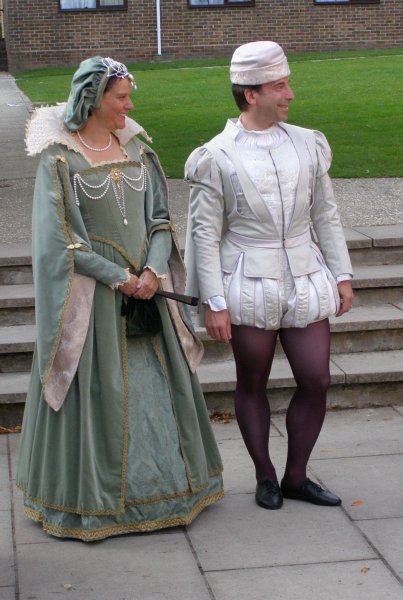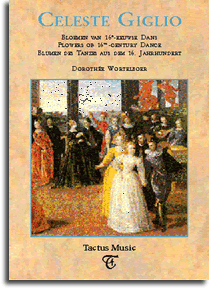|
General Background:
Online Resources
There is a wealth of information available online. Sites change addresses frequently, but you may find Renaissance Dance Links and Early Dance Texts on this site useful. A search of "Renaissance," "Dance," and/or "Shakespeare" will uncover many primary and secondary resources including all the works of Shakespeare and most of the original, dance manual texts on other sites. The Society for Creative Anachronism (SCA), Renaissance faires, early music organizations, and even Wikipedia entries may have links to useful sites. I have created a booklist on Amazon.com on how to "Dance Shakespeare". The main caveat is to be wary of misleading or incorrect information as there is no guarantee of authenticity or validity for information found on a website. |
|
International Encyclopedia of Dance: A project of Dance Perspectives Foundation, 1998.
Excellent general resource if you can find it. Recommended books and articles for further study follow each entry which are on every dance subject imaginable and written by the experts in every field. Relevant entries include: Galliard, Branle, Morris, Shakespeare, Great Britain. Expensive, but worth it!
|
Dance’s function in Shakespeare plays:
|
Brissenden, Alan. Shakespeare and the Dance. London: The MacMillan Press, 1981, 2001.
Essential text for studying dance references in the plays. Extensive analysis both of how dance functions as a plot device and how Shakespeare uses dance references within the text. While Brissenden gives no choreographies -- just the names of suggested dances for fifteen of the plays, he does provide a concise history of Renaissance court dance and explains how dance was viewed by the Elizabethans. Consult this text for specific dance references and for general themes in the different genres of tragedy, comedy, etc. Brissenden also includes a short, but well-chosen glossary of common dance terms and a substantial bibliography. |
Original Renaissance dance manuals and step reconstructions:
Modern editions of Renaissance dance manuals:
|
Payne, Ian. The Almain in Britain, c.1549-c.1675: A Dance Manual from Manuscript Sources. New York: Ashgate Publishing, Inc., 1995.
A scholarly edition of the collection of manuscript choreographies from c.1565-c.1675 associated with the Inns of Court, the nine dances sometimes referred to as the measures or old measures. Payne offers danceable and playable reconstructions for each dance, which is helpful for the would-be choreographer, as there is a great deal of uncertainty regarding exact steps, dance and music matching, etc. Although the book's extensive commentaries on steps, style, and music can seem overwhelming, the dances themselves are quite simple and can be learned easily by non-dancers. |
|
Arbeau, Thoinot. Orchesography. Langres, 1589. Translated by Mary Stewart Evans; Introduction and Notes by Julia Sutton. New York: Dover Publications, Inc., 1967.
The essential text for any beginning Renaissance dance reconstructor. The dances--mostly branles and galliard combinations--are simple and straightforward as are their explanations although the step names are left in their original French. There are some original illustrations of the steps as well as Labanotation, and Julia Sutton’s editiorial comments though detailed, are easily understood. Arbeau gives the melody line for all the dances although arrangements from other sources are recommended for performance. Arbeau’s highly amusing but still relevant defense of dancing makes great reading, and there is also a lengthy section on dance and marching drumbeats. |
|
Caroso, Fabritio. Courtly Dance of the Renaissance: A New Translation and Edition of the "Nobilità di dame" (1600). Translated and edited by Julia Sutton. New York: Dover Publications, Inc., 1995.
Contains fairly elaborate and elegant dances with modern transcriptions of the lute tabulatures. (In other words, the music can be played on the piano right out of the book.) The dances, however, can be difficult to reconstruct from the book--despite Sutton’s extensive commentary and the Labanotation--if one does not already know the basic steps, and even then, it often unclear what steps occur on what counts of the music. However, the "Notes on Conduct," offering useful and entertaining advice for actors and dancers on how to sit, bow, and otherwise behave at balls and other social gatherings, requires no prior knowledge. |
Ready-made Dances & Recordings:
 |
DHDS dance booklets and CDs. (purchase)
There are a variety of relevant booklets that offer intrepretations of Renaissance dances from the fifteenth through seventeenth centuries. Booklets give clear, if sometimes contested, instructions for each dance, include at least the melody line for each dance, and have introductions and bibliographies for context and future study. Recordings of the music for each piece are available on CD. The recordings use the correct tempos and number of repititions for dancing, but are not usually full arrangements, so they may be better suited for practice than for providing music for a performance. |
|
Songs & Dances from Shakespeare. The Broadside Band. Director Jeremy Barlow. Wotton-Under-Edge, England: Saydisc Records, 1995.
This compact disc features songs and dances referred to or most likely used in the original productions and dances of the period as well as songs from early revivals of the plays. Lyrics for all songs are included as well as suggestions for which music should be used in which plays and helpful background material. In addition, Jeremy Barlow was the accompanist (or rather, harpsichordist) at the Dolmetsch Historical Dance Society Summer School I attended in England in August of 1998 and personally recommended music and instruments for my production, The Bard’s Galliard... or how to party like an Elizabethan. The Broadside Band also has recordings of Renaissance court dance music. |
 |
Wortelboer, Dorothée. Celeste Giglio: Flowers of 16th Century Dance. Amsterdam: Tactus Music, 1996. (purchase)
This is a secondary source, a modern dance manual with a detailed glossary of steps, sheet music arranged for three or four part ensembles, and an accompanying compact disc. The dances are primarily complicated Italian choreographies from Fabritio Caroso and Cesare Negri’s dance manuals with a few additions from Thoinot Arbeau and other dance masters. While one should always consult the original text, this manual offers workable interpretations of ambiguous passages and clearly specifies what steps should be done during what bar of music. Some adjustments may be necessary in performance on the stage, however, as most of the dances are long, physically arduous, and frequently have a dancer’s back to the audience. |
Renaissance Dance DVDs:
|
Il Ballarino: The Art of Renaissance Dance. Dir. Julia Sutton. 2009.
Excellent introduction to Renaissance dance choreography and steps. Features three dances.
|
|
How to Dance through time: Vol. III. - The Majesty of Renaissance Dance. Dir. Carol Teton. 2000.
Less academically rigorous, but attractively produced.
|
Music scores and commentary:
|
Duffin, Ross W. Shakespeare's Songbook. New York: W. W. Norton & Company, 2004.
An extensive and well-researched collection of 160 songs included in or simply mentioned in Shakespeare plays, from ballads to ayres to dances to drinking songs. Entries include lyrics, musical notation, and editorial comments. With a foreward by Stephen Orgel and an accompanying CD with performances of many of the songs.
|
|
|
The Fitzwilliam Virginal Book. London, 1899. Edited by J. A. Fuller Mailand and W. Barclay Squire. New York: Dover Publications, 1963.
Two volumes, also known as Queen Elizabeth’s Virginal Book. Contains instrumental music contemporary with Shakespeare including William Byrd’s "O Mistris myne" sung in Twelfth Night. Unfortunately, there are few notes on the pieces, and half of them are in German. (Electronic excerpts). |
|
Four Hundred Songs & Dances From the Stuart Masque. Ed. Andrew Sabol. Hanover and London: Brown University Press, 1982. (out of print, check amongst scores in a music library)
The arrangements in the chapter "Dances for the Measures and Revels" are excellent for dances and processions in Shakespeare plays, just avoid those with too late a date. Several of the notes on the pieces refer to dancing, and Appendix C is John Ramsay’s "Practise for Danucinge," a description of 24 English dances from the Inns of Court. |
|
Naylor, Edward W. Shakespeare and Music. London: J.M. Dent & Co., 1896. (out of print, check Shakespeare section of library)
Whole chapter on dancing founded on Arbeau’s Orchesography and references to dancing by Thomas Morley and other Shakespeare contemporaries. Detailed explanation of dance and music vocabulary in the plays and more hints at choreography than Brissenden’s analysis. While one of two of Naylor’s acknowledged suppositions are no longer believed true, this is still an extremely useful text. Naylor offers unusually clear explanations of rhythm as well as information regarding processions and entrances and exits not found in other texts. |
|
Lindley, David. Shakespeare And Music (Arden Critical Companions). Arden Shakespeare, 2005.
Lindley is a well-known scholar who has written on music in the court masque among other related topics. |
** Special Collections **
There are several wonderful videos, tapes, and documents in the New York Public Library for the Performing Arts’s Dance Collection at Lincoln Center in New York City. Access to the collection is restricted by geography and videos can only be seen by appointment, But if you can arrange it, however, every effort should be made to visit the Dance Collection as it probably has the best public (or somewhat public) collection of Renaissance dance videos available anywhere.
The Folger Shakespeare Library in Washington, DC also has an extensive collection of primary and secondary dance works including original copies of Fabritio Caroso and Cesare Negri's dance manuals, as well as a phenomenal collection of all things Shakespearean. Access to the library is restricted to serious researchers -- see the Registrar for more details.
|



